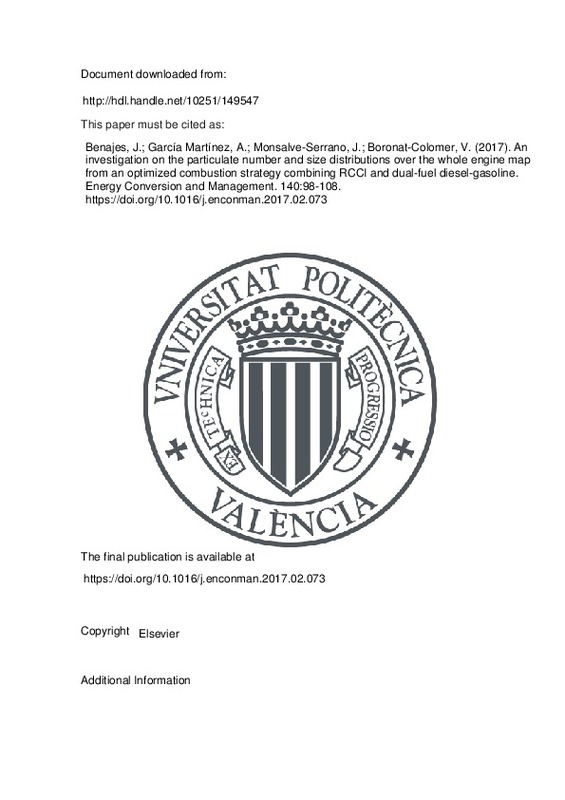JavaScript is disabled for your browser. Some features of this site may not work without it.
Buscar en RiuNet
Listar
Mi cuenta
Estadísticas
Ayuda RiuNet
Admin. UPV
An investigation on the particulate number and size distributions over the whole engine map from an optimized combustion strategy combining RCCI and dual-fuel diesel-gasoline
Mostrar el registro sencillo del ítem
Ficheros en el ítem
| dc.contributor.author | Benajes, Jesús
|
es_ES |
| dc.contributor.author | García Martínez, Antonio
|
es_ES |
| dc.contributor.author | Monsalve-Serrano, Javier
|
es_ES |
| dc.contributor.author | Boronat-Colomer, Vicente
|
es_ES |
| dc.date.accessioned | 2020-09-08T03:32:13Z | |
| dc.date.available | 2020-09-08T03:32:13Z | |
| dc.date.issued | 2017-05-15 | es_ES |
| dc.identifier.issn | 0196-8904 | es_ES |
| dc.identifier.uri | http://hdl.handle.net/10251/149547 | |
| dc.description.abstract | [EN] Literature demonstrates that, for premixed low temperature combustion concepts, particulate matter cannot be directly extrapolated from soot emissions measurements, as typically done for conventional diesel combustion. This is because the particulate matter from low temperature combustion has low fraction of carbonaceous compounds and great amount of soluble organic fraction, which is not captured by the smoke measurement techniques such as the optical reflectometry. By this reason, the study of the particulate matter characteristics from this combustion techniques requires using specific equipment. The aim of the current work is to gain understanding on the particulate matter characteristics from the dual-mode dual-fuel combustion, which is an optimized combustion strategy that combines fully and highly premixed RCCI regimes at low and medium loads, and switches to dual-fuel diffusion combustion at full load. The study was performed over the whole engine map, using a 15.3:1 compression ratio medium-duty EURO VI diesel engine. In particular, the particulate number and size distributions were sampled using a scanning mobility particle sizer and a condensation particle counter, which allow measuring the size distribution and total number of particles from 5 to 250 nm. Results demonstrate that the fully premixed RCCI combustion is dominated by small particles (less than 30 nm in mobility diameter), the dual-fuel diffusion mode is dominated by larger particles (around 100 nm in mobility diameter) showing more diesel-like particle size distributions, and the highly premixed reactivity controlled compression ignition regime shows a transitional particle size distribution with two peaks of mobility diameters around 20 and 80 nm. (C) 2017 Elsevier Ltd. All rights reserved. | es_ES |
| dc.description.sponsorship | This investigation has been funded by VOLVO Group Trucks Technology. The authors also acknowledge the Spanish economy and competitiveness ministry for partially supporting this research (HiReCo TRA2014-58870-R). The predoctoral contract of the author V. Boronat (FPI-S2-2017-2882) is granted by the Programa de Apoyo para la Investigación y Desarrollo (PAID) of the Universitat Politècnica de València. The author J. Monsalve-Serrano acknowledges the financial support from the Universitat Politècnica de València under the Grant Ayudas Para la Contratación de Doctores para el Acceso al Sistema Español de Ciencia, Tecnología e Innovación . | es_ES |
| dc.language | Inglés | es_ES |
| dc.publisher | Elsevier | es_ES |
| dc.relation.ispartof | Energy Conversion and Management | es_ES |
| dc.rights | Reconocimiento - No comercial - Sin obra derivada (by-nc-nd) | es_ES |
| dc.subject | Reactivity controlled compression ignition | es_ES |
| dc.subject | Dual-fuel combustion | es_ES |
| dc.subject | Dual-mode | es_ES |
| dc.subject | EURO VI emissions | es_ES |
| dc.subject | Efficiency | es_ES |
| dc.subject | Engine map | es_ES |
| dc.subject.classification | MAQUINAS Y MOTORES TERMICOS | es_ES |
| dc.title | An investigation on the particulate number and size distributions over the whole engine map from an optimized combustion strategy combining RCCI and dual-fuel diesel-gasoline | es_ES |
| dc.type | Artículo | es_ES |
| dc.identifier.doi | 10.1016/j.enconman.2017.02.073 | es_ES |
| dc.relation.projectID | info:eu-repo/grantAgreement/MINECO//TRA2014-58870-R/ES/REDUCCION DE LAS EMISIONES DE CO2 EN VEHICULOS PARA TRANSPORTE USANDO COMBUSTION DUAL NATURAL GAS-DIESEL/ | es_ES |
| dc.relation.projectID | info:eu-repo/grantAgreement/UPV//FPI-S2-2017-2882/ | es_ES |
| dc.rights.accessRights | Abierto | es_ES |
| dc.contributor.affiliation | Universitat Politècnica de València. Departamento de Máquinas y Motores Térmicos - Departament de Màquines i Motors Tèrmics | es_ES |
| dc.description.bibliographicCitation | Benajes, J.; García Martínez, A.; Monsalve-Serrano, J.; Boronat-Colomer, V. (2017). An investigation on the particulate number and size distributions over the whole engine map from an optimized combustion strategy combining RCCI and dual-fuel diesel-gasoline. Energy Conversion and Management. 140:98-108. https://doi.org/10.1016/j.enconman.2017.02.073 | es_ES |
| dc.description.accrualMethod | S | es_ES |
| dc.relation.publisherversion | https://doi.org/10.1016/j.enconman.2017.02.073 | es_ES |
| dc.description.upvformatpinicio | 98 | es_ES |
| dc.description.upvformatpfin | 108 | es_ES |
| dc.type.version | info:eu-repo/semantics/publishedVersion | es_ES |
| dc.description.volume | 140 | es_ES |
| dc.relation.pasarela | S\329022 | es_ES |
| dc.contributor.funder | Volvo Group Trucks Technology | es_ES |
| dc.contributor.funder | Universitat Politècnica de València | es_ES |
| dc.contributor.funder | Ministerio de Economía y Competitividad | es_ES |







![[Cerrado]](/themes/UPV/images/candado.png)

